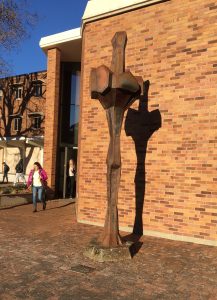Background:
Stephen Walcott Tibbetts was born in 1943 and created Scepter in 1966 while attending Western Washington University. He won a student competition when he designed the piece leading to its purchase by the Associated Students group. His piece was then constructed in Red Square on the Western Washington University campus. Unfortunately, little information about Steve Tibbetts remains besides some information regarding his other works. He designed chandeliers for the Whatcom Museum of History and Art and Machinations in the Mode of Senility for the Seattle Art Museum in 1967. Sadly, Tibbetts is now deceased.
Tibbetts sculpture was created in the mid-60’s when “junk art” was becoming widely popular. Junk art is composed of found objects (similar to Duchamp’s ready-mades) that have been repurposed to create new artwork. Junk art is both environmentally friendly and creative. Scepter’s brilliant use of old car parts as material symbolizes the concepts of reusing and recycling. 1960 was a difficult period because strides for change were being made by many, however, it was an extremely arduous and long-lasting fight for civil rights and progress.
The build of Tibbett’s piece comments on the strength of progressiveness in society because it has a strong and powerful build, yet, it’s composed of scrap metal, symbolizing a progressive environmental idea. This concept could imply the US’s search for it’s identity in this time as it rebuilds itself into something more progressive. What was once a stylish car from the 50’s became trash. Then, the 50’s trash was reinvented by Tibbetts in Scepter and became something completely new: a symbol for progress and strength.
About Scepter:
Steve Tibbetts’ use of scrap metal from old car parts as material for Scepter hints at his environmentally conscious intent when creating the piece. The artist crafted a brand new sculpture by repurposing material that was seen as garbage in other’s eyes. Tibbetts never appreciated the creation of unnecessary waste and this message comes across with his repurposing of scrap metal. Additionally, Tibbetts was inspired by the Spanish architect/ designer, Antoni Gaudi. Gaudi’s buildings played off of the natural world while creating complexity and beauty.
The piece stands about as tall as the lamp posts in Red Square. Its rusty hue sort of blends in with the surrounding bricks. It is often overlooked by passerby’s, but when noticed, it forces the viewer to react and interpret. Scepter looks like a tall staff, but could also be seen as a human figure. Many people see it differently.
Looking at the piece as a student in 2016, with a little bit of background, the issue of climate change and environmental disaster is more looming than ever before. Thus, a piece that seems to symbolizes innovation and environmental consciousness with the use of reused material is prevalent in today’s society. Now, more than ever before, people should be shifting their focus to protecting the environment and bringing awareness to the issue. Looking at Scepter with the knowledge of the creator’s environmental intent gives the viewer an entire new appreciation for what the piece symbolizes and how it stands so confidently, yet peacefully, in Red Square.
Scepter (1966):
Reaction to Scepter:
Here’s a brief video by Shawn Stawiarski:
Group 2:
Sarah Smith: photography, writing/ editing
Shawn Stawiarski: video production, research
Works Cited:
Art Inventories Catalog-Machinations in the Mode of Senility, (sculpture), Smithsonian American Institution, 2016.
Clark-Langager, Sarah A. Sculpture in place: a campus as site. Bellingham, Western Washington University, 2002.
Clark-Langager, Sarah. “Walking Tour with Artists.” Western Gallery, Western Washington University, 2006.
“Scepter, (sculpture).” Collections Search Center, Smithsonian Institution. Smithsonian Institurion, 01 Jan.1960.
University Public Art Collection. Bellingham, College of Fine and Performing Arts, Western Washington Universiity.

Leave a Reply